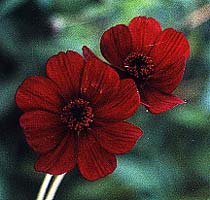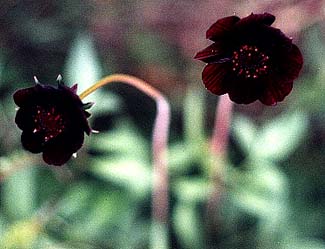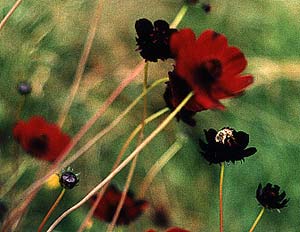
Chocolate Cosmos, mmmmmm, chocolate...
Not long ago I was looking at an array of gallon-pot offerings of chocolate cosmos at Bainbridge Nursery. I was suprised how small the flowers appeared compared to ours on a large & well-established clump. The nursery offering were small messy bird nests of foliage, & how overall unassuming the plants were. I assume ours looked liked this a few years ago when Granny Artemis first planted it, but memory of that has been erased by its performance in our yard. The nursery's customers were walking past these young cosmos giving them no glance; I had to fight an urge to grab people & tell them this flower would become a marvel in the garden, so grab one while you can, you won't be sorry.
Cosmos atrosanguineus, or Chocolate Cosmos, has such dark maroon flowers that they do occasionally approach the color of a Hershey's bar, though more the color of dried blood. It is occasionally called Black Cosmos, a flower suited to the Gothic Gardener.
Even more remarkable, they have a faint scent of chocolate. The chocolatiness is most evident as evening approaches, toward the end of a hot summery day.
 The bulk of the foliage clump is about three feet tall, a tangle that seems to be fighting against an urge to become prostrate, leaning into the sun. The wiry stems that uphold each bloom rise from three to four feet high which is well above the foliage, with other blooms lower within the embrace of the foliage.
The bulk of the foliage clump is about three feet tall, a tangle that seems to be fighting against an urge to become prostrate, leaning into the sun. The wiry stems that uphold each bloom rise from three to four feet high which is well above the foliage, with other blooms lower within the embrace of the foliage.Even apart from the novelty of its Hershey bar perfume, the flower is one of the prettiest. It offers excellent cuttings for bouquets. It begins blooming in May, picks up speed in June, & in July the clump is chock full of bobbling blooms that easily catch a breeze. It will continue to produce blooms through mild early frosts -- for us, the flowers appear in great numbers up to October with a few remaining in November, even without much deadheading. This rivals the Gaura in persistence of gorgeous blooms. In winter the clump dies to the ground.
We took out part of the clump this year, while it was still blooming, because we needed a good gift for a friend. It didn't interfer with the flowering one bit. If there is any drawback to this variety of cosmos, it is the fact that its foliage gets messier looking as the summer progresses, but it is difficult to prune because still in continuous flower. At the moment I have a plan to build a small circular ornamental fence for it next year, perhaps a foot & a half tall, encircling the entire two-foot-wide clump. This should trellis upward the half-prostrate clump so it doesn't crowd into neighboring flowers, & ought to improve the looks of the foliage so that it does justice to the marvelous flowers. Of course, the other way to freshen up a big tangled clump is to dig it up entirely & divide it into three or four plants, which eventually will have to be done.
 As a native of Mexico, Cosmos likes a lot of sun. Ours is in an all-afternoon-sunny location in moist well-draining soil next to a bushing Nishiki Willow. The chocolaty flowers are a lovely contrast to the pink summer leaves of the Nishiki. Though an established clump is supposed to be moderately drought tolerant, for the sake of the willow ours has never experienced much dryness, & has thrived in moist acidic soil. Possibly the clump would remain tidier if it did experience occasional dryness.
As a native of Mexico, Cosmos likes a lot of sun. Ours is in an all-afternoon-sunny location in moist well-draining soil next to a bushing Nishiki Willow. The chocolaty flowers are a lovely contrast to the pink summer leaves of the Nishiki. Though an established clump is supposed to be moderately drought tolerant, for the sake of the willow ours has never experienced much dryness, & has thrived in moist acidic soil. Possibly the clump would remain tidier if it did experience occasional dryness.Some gardeners recommend the tuberous root of the cosmos be dug up in autumn & stored like a treasured dahlia, & others recommend it for container-gardening so that it will be easier to bring to shelter in winter. Perhaps such measures would be required in some zones, but I'm surprised when I hear about any of my fellow Northwest gardeners going to such effort. Ours has been left in the ground three years & each spring has come back a larger & more spectacular bloomer. So on temperate Puget Sound it seems unnecessary to store the tuber.
The tuber can be divided in spring. We've never yet dug ours up to divide, as it's my understanding it develops slowly, especially in temperate climates, nor does it seed easily, which is why it is not one of the most common garden offerings, with demand outstripping availability.